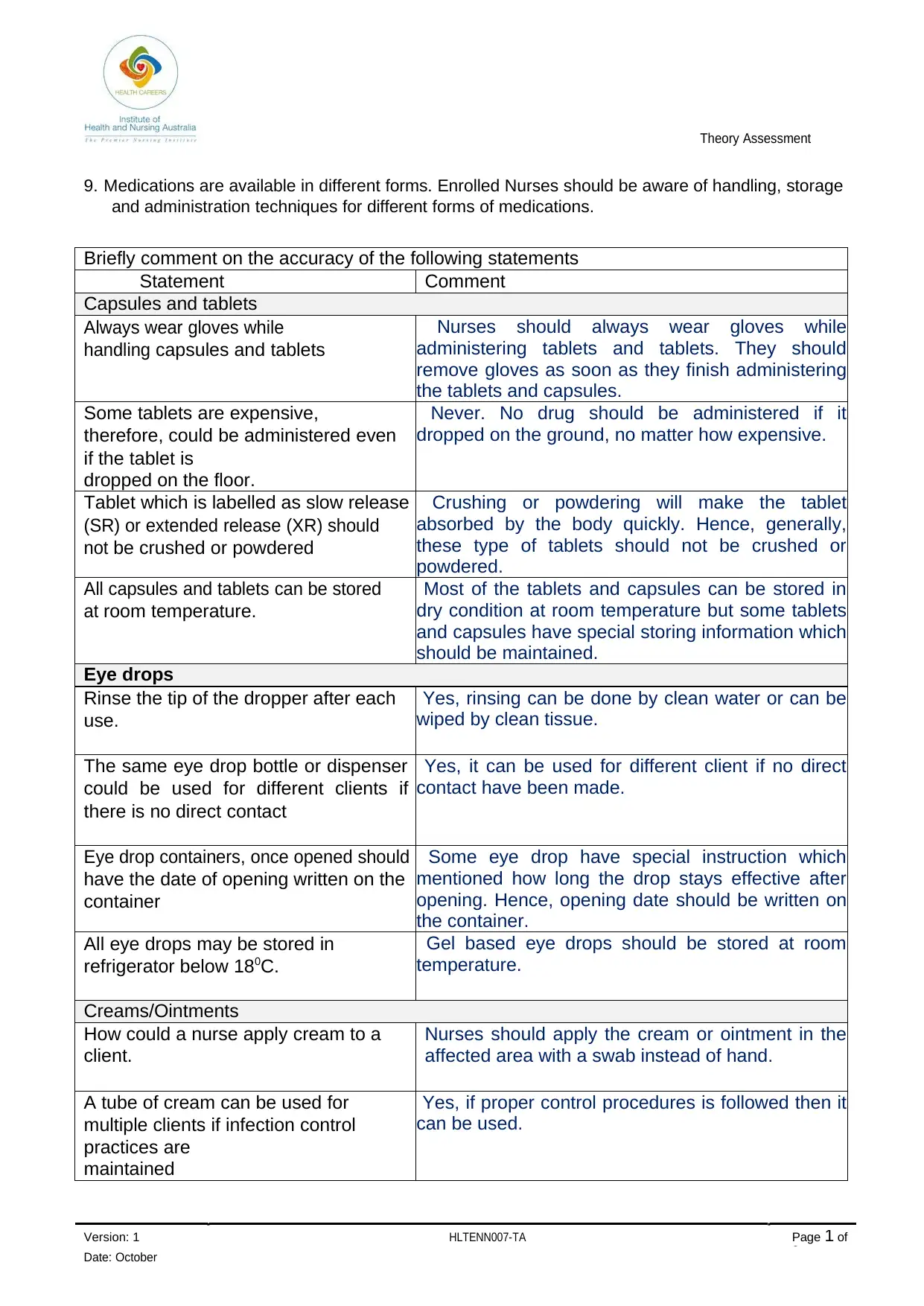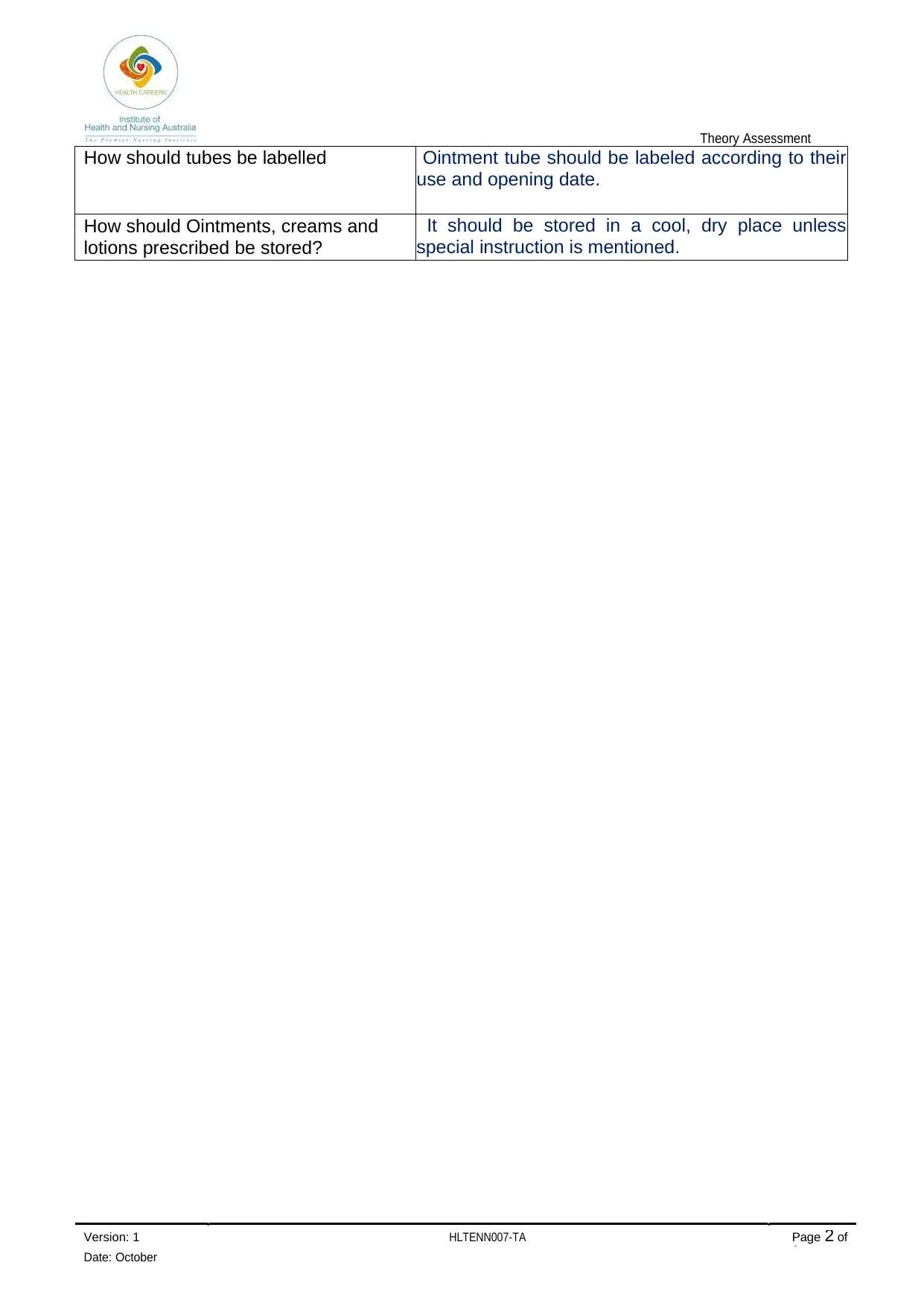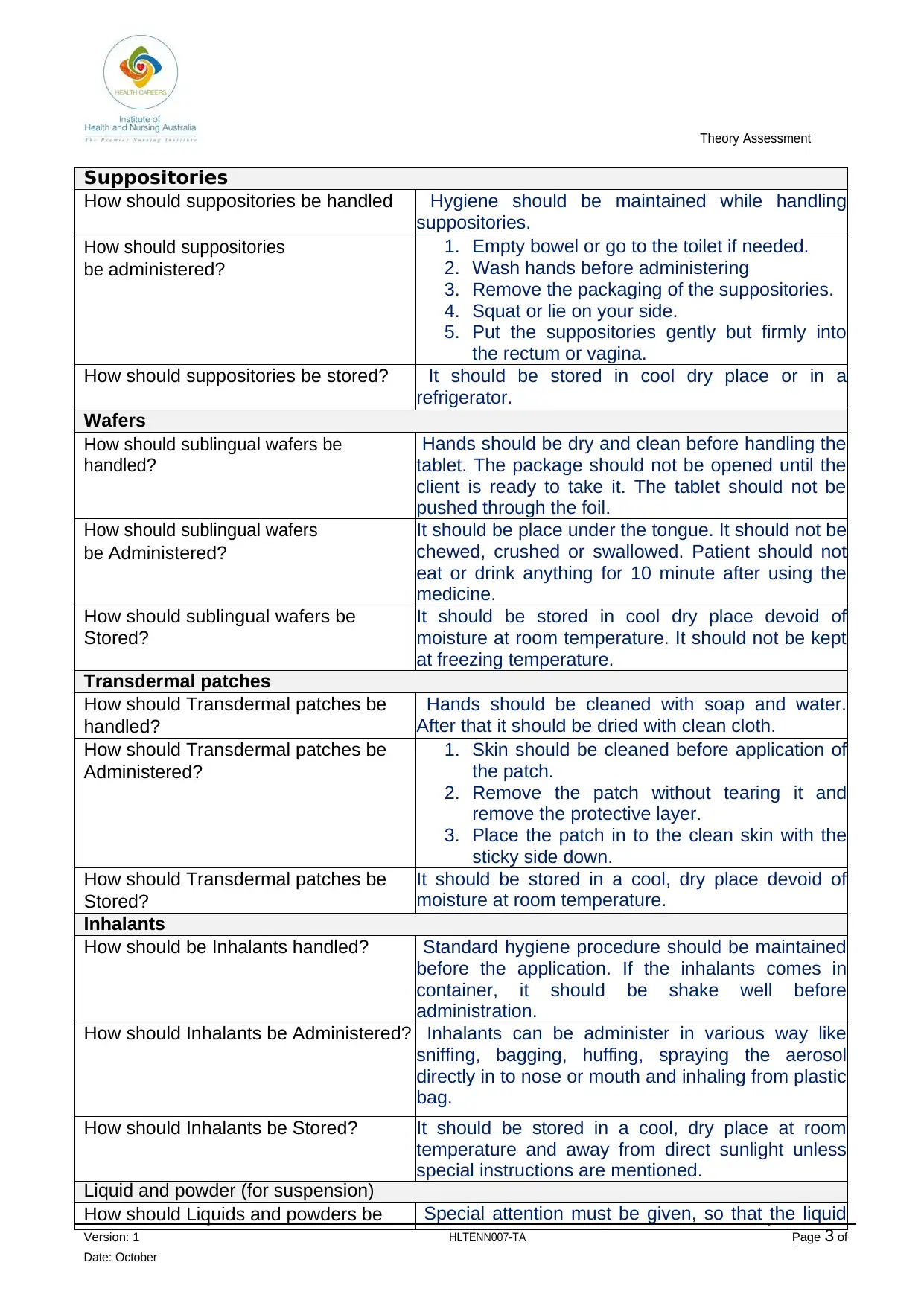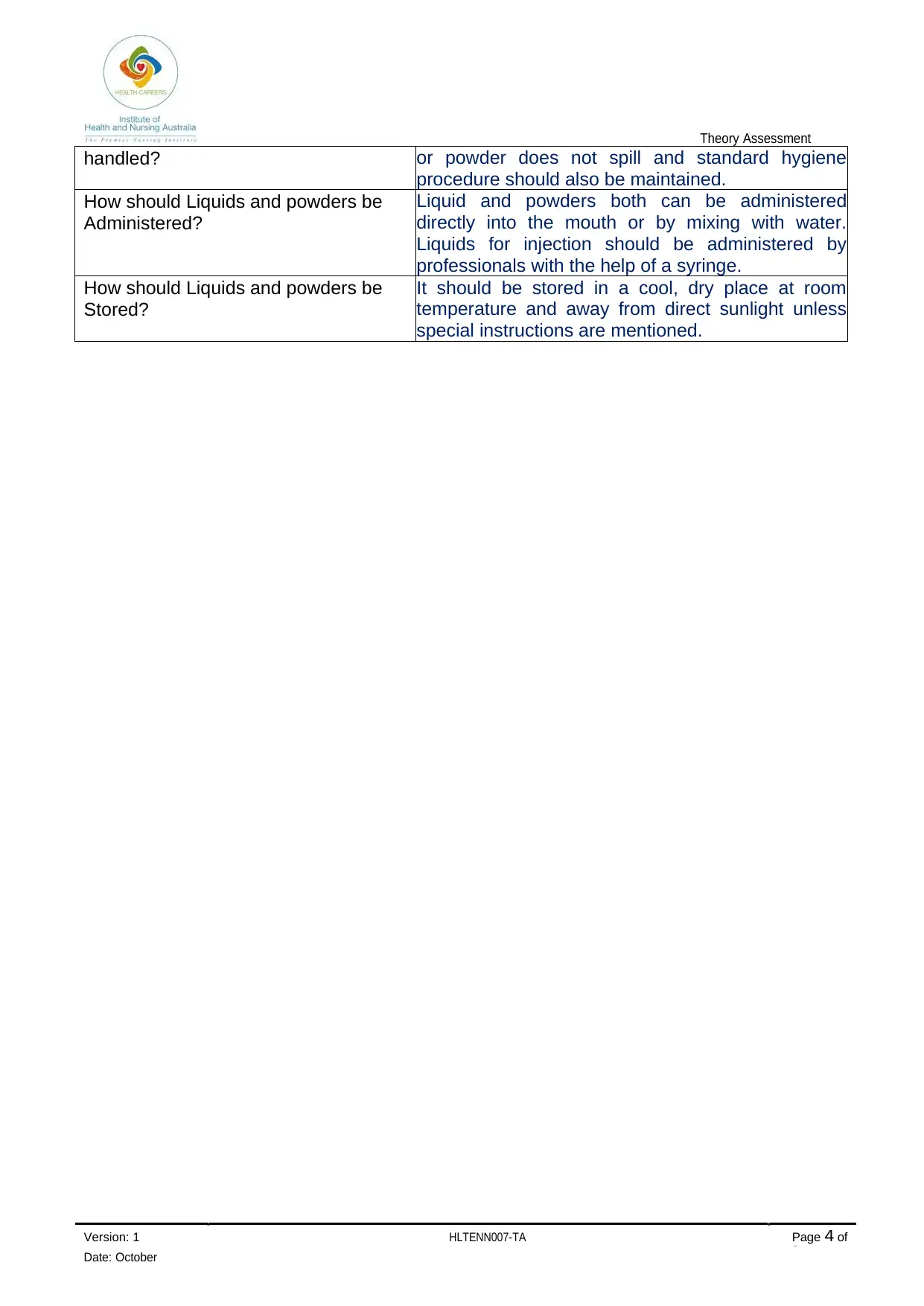HLTENN007 Theory Assessment: Medication Handling, Storage & Admin
VerifiedAdded on 2023/06/10
|4
|1008
|420
Homework Assignment
AI Summary
This assignment provides a detailed overview of the handling, storage, and administration techniques for various medication forms, including capsules, tablets, eye drops, creams, ointments, suppositories, wafers, transdermal patches, inhalants, and liquid/powder medications. It emphasizes the importance of proper hygiene, infection control, and adherence to specific storage instructions for each medication type. The assessment covers key considerations such as wearing gloves, avoiding contamination, appropriate application methods, and correct storage conditions to ensure medication efficacy and patient safety. The document highlights the need for nurses to be well-informed about the unique characteristics of each medication form to prevent errors and optimize therapeutic outcomes.

Theory Assessment
Version: 1
Date: October
2016
HLTENN007-TA Page 1 of
2
9. Medications are available in different forms. Enrolled Nurses should be aware of handling, storage
and administration techniques for different forms of medications.
Briefly comment on the accuracy of the following statements
Statement Comment
Capsules and tablets
Always wear gloves while
handling capsules and tablets
Nurses should always wear gloves while
administering tablets and tablets. They should
remove gloves as soon as they finish administering
the tablets and capsules.
Some tablets are expensive,
therefore, could be administered even
if the tablet is
dropped on the floor.
Never. No drug should be administered if it
dropped on the ground, no matter how expensive.
Tablet which is labelled as slow release
(SR) or extended release (XR) should
not be crushed or powdered
Crushing or powdering will make the tablet
absorbed by the body quickly. Hence, generally,
these type of tablets should not be crushed or
powdered.
All capsules and tablets can be stored
at room temperature.
Most of the tablets and capsules can be stored in
dry condition at room temperature but some tablets
and capsules have special storing information which
should be maintained.
Eye drops
Rinse the tip of the dropper after each
use.
Yes, rinsing can be done by clean water or can be
wiped by clean tissue.
The same eye drop bottle or dispenser
could be used for different clients if
there is no direct contact
Yes, it can be used for different client if no direct
contact have been made.
Eye drop containers, once opened should
have the date of opening written on the
container
Some eye drop have special instruction which
mentioned how long the drop stays effective after
opening. Hence, opening date should be written on
the container.
All eye drops may be stored in
refrigerator below 180C.
Gel based eye drops should be stored at room
temperature.
Creams/Ointments
How could a nurse apply cream to a
client.
Nurses should apply the cream or ointment in the
affected area with a swab instead of hand.
A tube of cream can be used for
multiple clients if infection control
practices are
maintained
Yes, if proper control procedures is followed then it
can be used.
Version: 1
Date: October
2016
HLTENN007-TA Page 1 of
2
9. Medications are available in different forms. Enrolled Nurses should be aware of handling, storage
and administration techniques for different forms of medications.
Briefly comment on the accuracy of the following statements
Statement Comment
Capsules and tablets
Always wear gloves while
handling capsules and tablets
Nurses should always wear gloves while
administering tablets and tablets. They should
remove gloves as soon as they finish administering
the tablets and capsules.
Some tablets are expensive,
therefore, could be administered even
if the tablet is
dropped on the floor.
Never. No drug should be administered if it
dropped on the ground, no matter how expensive.
Tablet which is labelled as slow release
(SR) or extended release (XR) should
not be crushed or powdered
Crushing or powdering will make the tablet
absorbed by the body quickly. Hence, generally,
these type of tablets should not be crushed or
powdered.
All capsules and tablets can be stored
at room temperature.
Most of the tablets and capsules can be stored in
dry condition at room temperature but some tablets
and capsules have special storing information which
should be maintained.
Eye drops
Rinse the tip of the dropper after each
use.
Yes, rinsing can be done by clean water or can be
wiped by clean tissue.
The same eye drop bottle or dispenser
could be used for different clients if
there is no direct contact
Yes, it can be used for different client if no direct
contact have been made.
Eye drop containers, once opened should
have the date of opening written on the
container
Some eye drop have special instruction which
mentioned how long the drop stays effective after
opening. Hence, opening date should be written on
the container.
All eye drops may be stored in
refrigerator below 180C.
Gel based eye drops should be stored at room
temperature.
Creams/Ointments
How could a nurse apply cream to a
client.
Nurses should apply the cream or ointment in the
affected area with a swab instead of hand.
A tube of cream can be used for
multiple clients if infection control
practices are
maintained
Yes, if proper control procedures is followed then it
can be used.
Paraphrase This Document
Need a fresh take? Get an instant paraphrase of this document with our AI Paraphraser

Theory Assessment
Version: 1
Date: October
2016
HLTENN007-TA Page 2 of
2
How should tubes be labelled Ointment tube should be labeled according to their
use and opening date.
How should Ointments, creams and
lotions prescribed be stored?
It should be stored in a cool, dry place unless
special instruction is mentioned.
Version: 1
Date: October
2016
HLTENN007-TA Page 2 of
2
How should tubes be labelled Ointment tube should be labeled according to their
use and opening date.
How should Ointments, creams and
lotions prescribed be stored?
It should be stored in a cool, dry place unless
special instruction is mentioned.

Theory Assessment
Version: 1
Date: October
2016
HLTENN007-TA Page 3 of
2
Suppositories
How should suppositories be handled Hygiene should be maintained while handling
suppositories.
How should suppositories
be administered?
1. Empty bowel or go to the toilet if needed.
2. Wash hands before administering
3. Remove the packaging of the suppositories.
4. Squat or lie on your side.
5. Put the suppositories gently but firmly into
the rectum or vagina.
How should suppositories be stored? It should be stored in cool dry place or in a
refrigerator.
Wafers
How should sublingual wafers be
handled?
Hands should be dry and clean before handling the
tablet. The package should not be opened until the
client is ready to take it. The tablet should not be
pushed through the foil.
How should sublingual wafers
be Administered?
It should be place under the tongue. It should not be
chewed, crushed or swallowed. Patient should not
eat or drink anything for 10 minute after using the
medicine.
How should sublingual wafers be
Stored?
It should be stored in cool dry place devoid of
moisture at room temperature. It should not be kept
at freezing temperature.
Transdermal patches
How should Transdermal patches be
handled?
Hands should be cleaned with soap and water.
After that it should be dried with clean cloth.
How should Transdermal patches be
Administered?
1. Skin should be cleaned before application of
the patch.
2. Remove the patch without tearing it and
remove the protective layer.
3. Place the patch in to the clean skin with the
sticky side down.
How should Transdermal patches be
Stored?
It should be stored in a cool, dry place devoid of
moisture at room temperature.
Inhalants
How should be Inhalants handled? Standard hygiene procedure should be maintained
before the application. If the inhalants comes in
container, it should be shake well before
administration.
How should Inhalants be Administered? Inhalants can be administer in various way like
sniffing, bagging, huffing, spraying the aerosol
directly in to nose or mouth and inhaling from plastic
bag.
How should Inhalants be Stored? It should be stored in a cool, dry place at room
temperature and away from direct sunlight unless
special instructions are mentioned.
Liquid and powder (for suspension)
How should Liquids and powders be Special attention must be given, so that the liquid
Version: 1
Date: October
2016
HLTENN007-TA Page 3 of
2
Suppositories
How should suppositories be handled Hygiene should be maintained while handling
suppositories.
How should suppositories
be administered?
1. Empty bowel or go to the toilet if needed.
2. Wash hands before administering
3. Remove the packaging of the suppositories.
4. Squat or lie on your side.
5. Put the suppositories gently but firmly into
the rectum or vagina.
How should suppositories be stored? It should be stored in cool dry place or in a
refrigerator.
Wafers
How should sublingual wafers be
handled?
Hands should be dry and clean before handling the
tablet. The package should not be opened until the
client is ready to take it. The tablet should not be
pushed through the foil.
How should sublingual wafers
be Administered?
It should be place under the tongue. It should not be
chewed, crushed or swallowed. Patient should not
eat or drink anything for 10 minute after using the
medicine.
How should sublingual wafers be
Stored?
It should be stored in cool dry place devoid of
moisture at room temperature. It should not be kept
at freezing temperature.
Transdermal patches
How should Transdermal patches be
handled?
Hands should be cleaned with soap and water.
After that it should be dried with clean cloth.
How should Transdermal patches be
Administered?
1. Skin should be cleaned before application of
the patch.
2. Remove the patch without tearing it and
remove the protective layer.
3. Place the patch in to the clean skin with the
sticky side down.
How should Transdermal patches be
Stored?
It should be stored in a cool, dry place devoid of
moisture at room temperature.
Inhalants
How should be Inhalants handled? Standard hygiene procedure should be maintained
before the application. If the inhalants comes in
container, it should be shake well before
administration.
How should Inhalants be Administered? Inhalants can be administer in various way like
sniffing, bagging, huffing, spraying the aerosol
directly in to nose or mouth and inhaling from plastic
bag.
How should Inhalants be Stored? It should be stored in a cool, dry place at room
temperature and away from direct sunlight unless
special instructions are mentioned.
Liquid and powder (for suspension)
How should Liquids and powders be Special attention must be given, so that the liquid
⊘ This is a preview!⊘
Do you want full access?
Subscribe today to unlock all pages.

Trusted by 1+ million students worldwide

Theory Assessment
Version: 1
Date: October
2016
HLTENN007-TA Page 4 of
2
handled? or powder does not spill and standard hygiene
procedure should also be maintained.
How should Liquids and powders be
Administered?
Liquid and powders both can be administered
directly into the mouth or by mixing with water.
Liquids for injection should be administered by
professionals with the help of a syringe.
How should Liquids and powders be
Stored?
It should be stored in a cool, dry place at room
temperature and away from direct sunlight unless
special instructions are mentioned.
Version: 1
Date: October
2016
HLTENN007-TA Page 4 of
2
handled? or powder does not spill and standard hygiene
procedure should also be maintained.
How should Liquids and powders be
Administered?
Liquid and powders both can be administered
directly into the mouth or by mixing with water.
Liquids for injection should be administered by
professionals with the help of a syringe.
How should Liquids and powders be
Stored?
It should be stored in a cool, dry place at room
temperature and away from direct sunlight unless
special instructions are mentioned.
1 out of 4
Related Documents
Your All-in-One AI-Powered Toolkit for Academic Success.
+13062052269
info@desklib.com
Available 24*7 on WhatsApp / Email
![[object Object]](/_next/static/media/star-bottom.7253800d.svg)
Unlock your academic potential
Copyright © 2020–2025 A2Z Services. All Rights Reserved. Developed and managed by ZUCOL.


